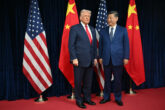June 13, 2016
Smarter Naval Power in the Indo-Pacific Region
In this paper, CNAS Military Fellow Commander Jennifer Couture points out that countering China’s A2/AD strategies in the future not only requires advanced technology, but calls for finding new ways to employ forces and capabilities already in the Navy’s inventory. She suggests that the exercise of naval power through forward presence, maritime security operations, engagement with partners and China allows the US to maintain access and influence to the Asia-Pacific region under current conditions; growing Chinese A2/AD challenges, however, require the US military to adopt alternative planning assumptions in terms of the scale of conflict (limited war), posture of unit (distributed lethality), scope of presence (pivot to Asia), and degree of ally integration (Operational-level).
The report is available online.
More from CNAS
-
North Korea Reveals Troop Dispatch to Russia amid U.S.-South Korea Policy Talks
North Korea has confirmed for the first time that its troops are operating in Russia, and it is preparing to rewrite its party charter with the possibility of officially namin...
By Dr. Go Myong-Hyun
-
Chinese Maker of Bitcoin-Mining Machines Is a Security Threat, Says Expert
Bloomberg News reports that a Chinese manufacturer, Bitmain Technologies Ltd, that sells most of the world’s Bitcoin-mining machines — including 16,000 of them to a venture ba...
By David Feith
-
Indo-Pacific Security / Energy, Economics & Security
North Korea’s Provocations, Power Plays, and Shifting AlliancesTensions on the Korean Peninsula have reached a new and dangerous threshold. President Lee Jae Myung is warning of a real risk of accidental military clashes, as the situation...
By Dr. Go Myong-Hyun
-
Indo-Pacific Security / Energy, Economics & Security
How to Win the Economic War with ChinaTrump's approach to China has run aground, giving Beijing unprecedented advantage in the economic conflict....
By Edward Fishman & Julian Gewirtz



